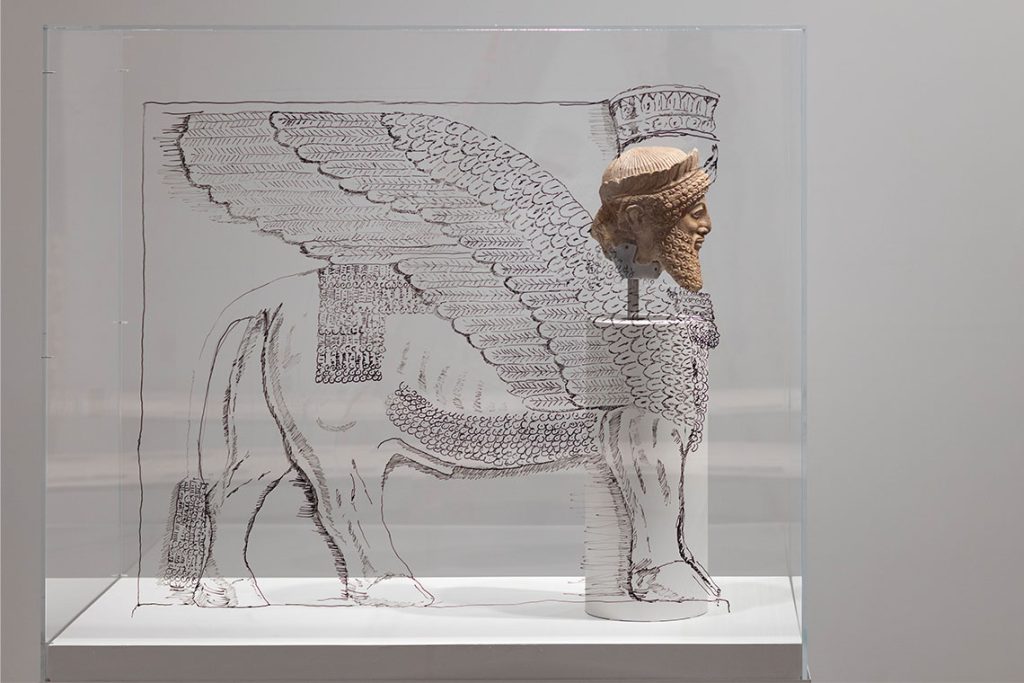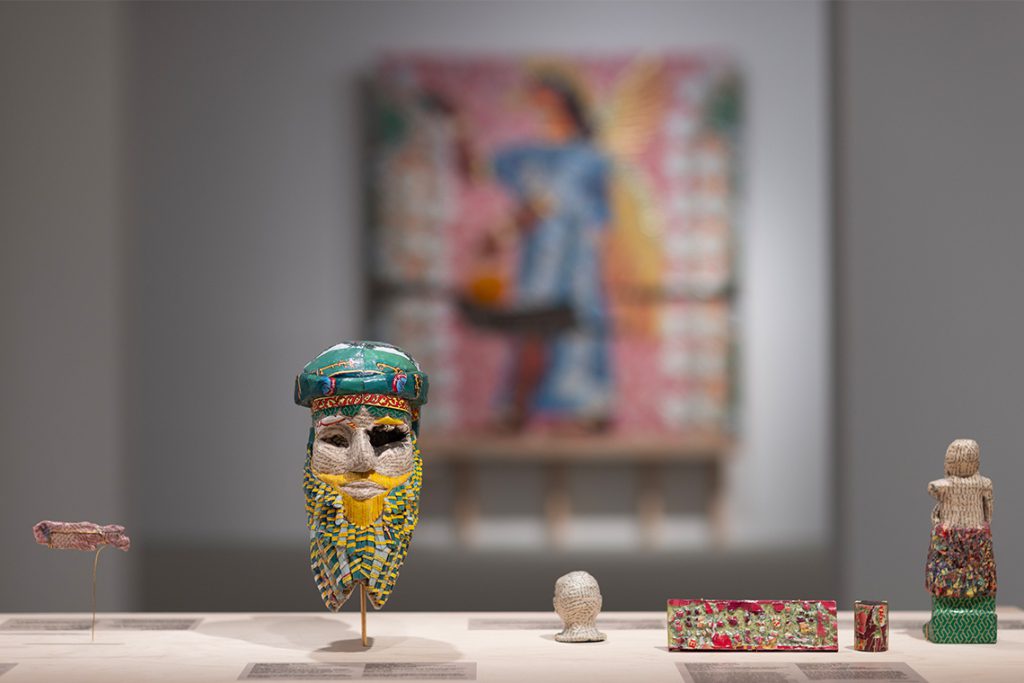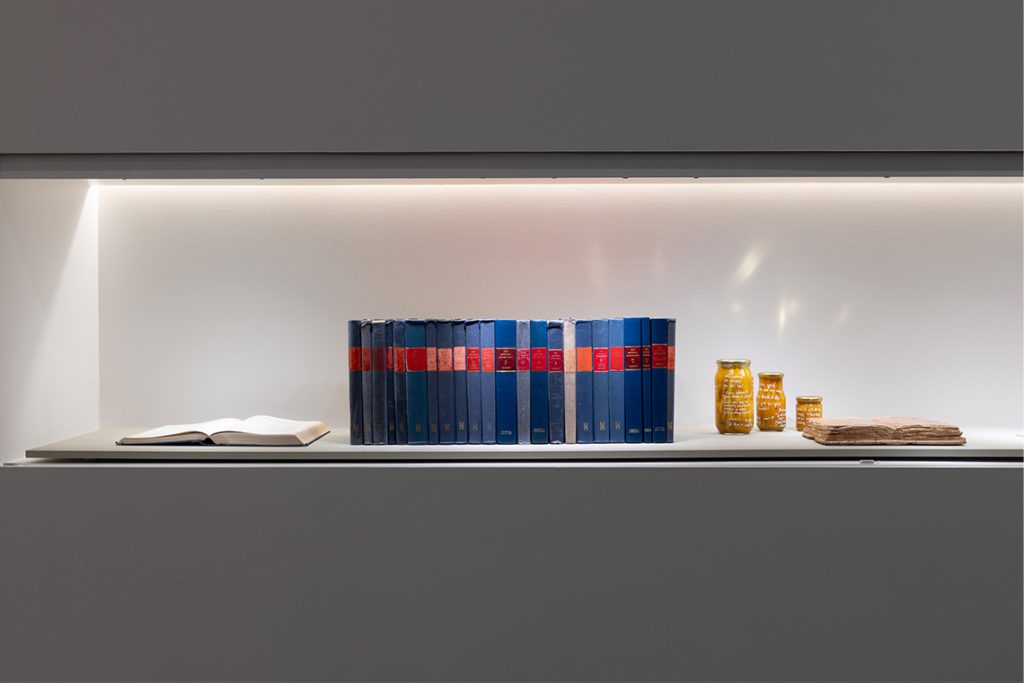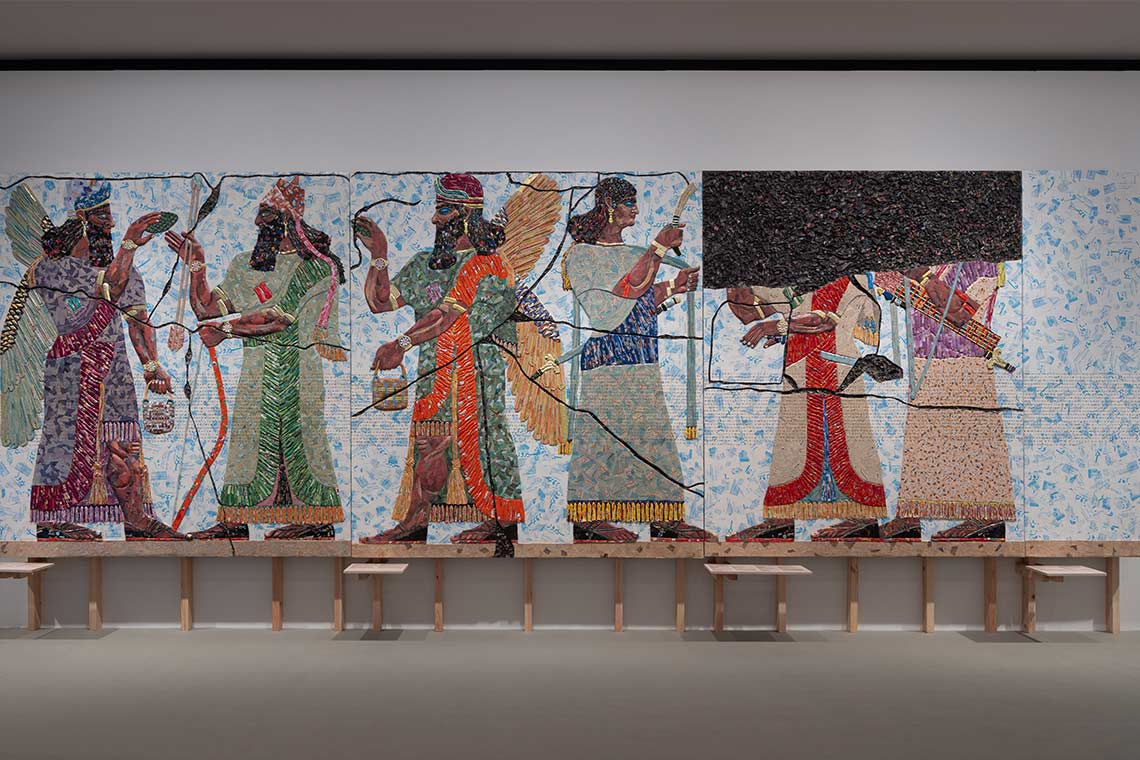As the first part of a major trilogy in Athens, Allspice confronts the trauma of cultural erasure with poetic resistance, transforming absence into presence through food, language, memory and “reappeared” antiquities.
The Acropolis Museum’s Temporary Exhibition Gallery is currently hosting Allspice | Michael Rakowitz & Ancient Cultures, a profound first chapter in a trilogy of exhibitions unfolding through 2025 and 2026 in Athens. This ambitious collaboration between the Hellenic Ministry of Culture, the Acropolis Museum, the Ephorate of Antiquities of Athens and NEON initiates a multidimensional conversation between ancient civilisations of the southeastern Mediterranean and the Middle East and the pressing realities of contemporary cultural loss, displacement and diaspora.
At the heart of this trilogy is Michael Rakowitz, the Iraqi-American artist whose sculptural and installation works engage directly with the fragmented legacies of looted and destroyed antiquities. Allspice marks not just a meeting point of epochs and cultures but also an emotional and political reckoning with the unresolved trauma of cultural theft and the erasure of identity.
Set against the physical and symbolic absence of the Parthenon sculptures – the ‘missing’ marbles still held in the British Museum – Rakowitz’s exhibition resonates deeply with the museum’s own narrative. His sculptures serve, as he sees it, as “substitutes or placeholders” for other sculptures that have disappeared or been destroyed, a concept echoed in the Latin root of the word ‘substitute’ – substituere – which itself stems from statuere, meaning ‘to set up’ or ‘to place’ and also the root of the English word ‘statue’. This linguistic connection mirrors his artistic practice: rather than erasing absence, he reveals it, transforming loss into presence.

The exhibition’s title draws from Rakowitz’s mother’s Iraqi recipes and holds rich symbolic weight. Allspice “holds in itself the flavours of other spices,” acting as a “perfect substitute” when other ingredients are unavailable – a culinary metaphor for survival and cultural perseverance. For Rakowitz, the spice embodies this “steadfastness”, much like his sculptures act as placeholders for vanished cultural heritage, affirming that memory and identity persist despite displacement.
As co-curator Elina Kountouri reflects, Rakowitz’s works “don’t aim to replicate, they aim to converse. They bring the past into dialogue with the present, making the ancient urgently contemporary.” Nowhere is this more apparent than in Rakowitz’s reimagined artefacts from the long-running series The invisible enemy should not exist (2007–), a monumental project that aims to recreate over 7000 artefacts destroyed or looted from the National Museum of Iraq in Baghdad during and after the US invasion of 2003. Using Middle Eastern food packaging and cuttings from Arabic-English newspapers collected from diasporic communities in the US, Rakowitz creates “reappearances” rather than reconstructions, a term he prefers for its conveyance of “making something like a scar […] something that could fill the space, but also be very clear that it was not the original.” Kountouri agrees. “Reappearance is a more poetic and political gesture,” she says. “It acknowledges that the trauma of loss can’t be undone, but perhaps it can be re-narrated.”
Among the three new commissions created for Allspice, a stand-out is Study for a Lamassu in spolia, where Rakowitz sketches the majestic body of a lamassu – a protective Assyrian deity with a bull’s body, eagle’s wings and a human head – directly onto the glass of a vitrine containing an ancient stone male head. Carved with Greco-Phoenician features and wearing a laurel wreath, it once belonged to a full-bodied statue from a sanctuary in Cyprus. Rakowitz’s intervention proposes a speculative, anachronistic union of cultures. “It recalls the practice of spolia, where fragments of older artworks and architecture were recontextualised in new constructions,” explains Kountouri. The gesture bridges cultural and temporal distances, reminding us that identity and heritage are always in flux, continuously negotiated.

In A Baghdadi Amba Dictionary, another new commission, Rakowitz preserves more than just pickled mango. Each jar of homemade amba – a condiment shared across Iraqi communities – is inscribed with Iraqi-Jewish sayings passed down from his mother. “Among the things that constitute this beautiful overlap between all our communities… are our culinary histories,” he explains. Amba, brought to Iraq by Baghdadi merchants trading in nineteenth-century India, here serves as a metaphor for cultural continuity across displacement.
The work responds to the Chicago Assyrian Dictionary, honouring the preservation of language through Rakowitz’s own diasporic lens. “Inspired by the Assyrian community who are preserving their languages,” he says, “what I wanted to do was find ways that I can not only preserve this Iraqi Jewish dialect but also say it in exactly the way that my mother does… even if there’s some slippage or a mistake. That’s part of it.” The result is a tactile, fragrant glossary – handwritten in impermanent grease pencil – that captures memory in a state as fluid and vulnerable as the community from which it speaks.
Allspice is not simply a show of objects – it is an exhibition of gaps. Between the recreated reliefs from the Northwest Palace of Kalhu (Nimrud), Rakowitz has left deliberate empty spaces. These absences, accompanied by textual labels, are what Kountouri describes as “material”. They demand active interpretation from the viewer, confronting them with what has been erased and asking why.
This refusal to simply mourn is central to Rakowitz’s practice. As Kountouri puts it, “Michael’s work doesn’t just mourn loss, it resists it. That act of ‘reappearance’ becomes both a form of healing and of protest. The empty labels function as strong reminders – naming what cannot be seen, what has been taken.” In the context of the Acropolis Museum, where the absence of the Parthenon Marbles is already a heavy presence, these gestures resonate with exceptional poignancy.

Rakowitz’s work also foregrounds humour and playfulness as forms of resistance. Upon entering the exhibition, the visitor is greeted with The Ballad of Special Ops Cody (2017), a video in which a toy soldier speaks to ancient statues in a vitrine, pleading with them to escape and return home. While deceptively light in tone, the work underscores a serious critique of the museum as a space of confinement and alienation.
For Kountouri, Allspice is not about perfect restoration, but about embracing the complexity of cultural loss. Equally, the exhibition insists that restitution is more than a legal or diplomatic matter. “Reappearance allows room for imagination, absence, and even error,” she asserts. “It’s about dignity, sovereignty, and identity.” By reimagining lost objects through contemporary materials and diasporic memories, Rakowitz’s work creates a space where absence is palpable but not silent. It demands accountability and empathy: connecting the unresolved trauma of the Parthenon Marbles with a global conversation about cultural justice and belonging.
The broader trilogy, continuing later in 2025 with the large-scale installation of Rakowitz’s Lamassu of Nineveh (originally created for London’s Trafalgar Square) and concluding at the Old Acropolis Museum in 2026, promises to deepen this conversation.
Allspice | Michael Rakowitz & Ancient Cultures runs until 31 October



